'Bickering' flies make evolutionary point

When a male fruit fly gets aggressive, he rears up on his back four legs and batters his foe with his front pair. Neither fly seems particularly damaged by the encounter, but their subsequent actions are telling about the ways of social evolution, according to Rice University evolutionary biologist Julia Saltz.
Saltz went to the fruit fly fights every day for months to find out how the creatures' genotypes—the genetic code that determines what they are—affect their phenotypes—the characteristics they present to their fellow flies.
In doing so, she bolstered the longstanding hypothesis in psychology that individuals are not merely subject to their social environments, but choose and create them through their interactions.
By placing genetically distinct variants of flies in various and sometimes uncomfortable situations, Saltz observed their behavior under stress and how stress altered the behavior of interacting individuals—a process called social-environment construction—when the "stressed" fly was moved to a new group for further observation.
"The main takeaway is that individuals' behaviors affect their social environments," she said. "In other words, when you pick your friends, it matters to you and it affects both what happens in the group and your behavior at a later time."
The study appears in the Nature journal Heredity.
Saltz, an assistant professor of biosciences, said few have undertaken direct studies of social-environment construction because of the difficulty involved. "You can't do it with people," she said, noting that it would be "unwise" to send someone into a room of subjects and have that person punch another.
But fruit flies are a worthy substitute, as both their genetic traits and environments can be manipulated easily, Saltz said.
Saltz, sole author of the paper, observed focal males - her primary subjects - either alone or with small groups of 2 to 8 fruit flies over two days in each experiment. (They totaled 1,300 flies over many months.) She placed genetically identical pairs in either their preferred or nonpreferred environments—either large or small groups—and measured their aggressive behaviors. She noted different genotypes of fly have different group-size preferences, allowing for variation among the experiments.
In the first stage of the study, she determined the preferences of focal males by genotype for group size. In the second stage, over hundreds of experiments, she put individual focal males into various-sized groups of "stimulus" flies.
"For day one, I put a 'genotype one' focal male with a group of flies, and a 'genotype two' with a replica group with the same sex ratio, number and genotype, reared under standard lab conditions," she said. "That way, I knew the social environment was the same for both focal males. If there was something different about how the groups behaved, it had to be due to the genotype of that one extra male.
"Arguably, the focal male would influence the behavior of other individuals in the group, which is what we saw," Saltz said.
She said males in their preferred groups were attacked more frequently than those in nonpreferred groups. "We don't totally know why that is, but we can say for sure the combination of that male's genotype and its preference caused the other males to act more aggressively toward it."
On day two, Saltz took the focal males—dabbed with yellow paint to identify them—from their initial groups and put each with a single "naïve" male in a petri dish "arena" and found the previous day's experience made them less aggressive.
That may show what Saltz called the "loser" effect, in which males who lose an initial encounter are less aggressive in subsequent encounters. "That seems to be true here, except that there's no good definition of losing," she said. "That's why I like to think of it as being attacked more often."
Saltz noted the flies display other types of aggression, and they may also pass chemical signals that are relevant in social environments. But lunging attacks were easiest to measure.
"It's an open question of how damaging aggression is to flies, but they seem totally fine after, so it's not like they can kill another male and then get all the food," she said. "There are subcomponents of aggression that are slightly ambiguous, but for this study I measured lunging, which doesn't look like any other behavior.
"The male actually rears up. The front two legs and part of its body go up and it slams its legs onto another male. It's not ambiguous, and a male can only lunge at one other male at a time, so you know exactly who was being aggressive and who was the recipient."
Saltz said future studies involving larger sets and more genotypes should help show how behavior and evolutionary fitness are affected by group size and composition. She also noted studying fruit flies for two days out of their average 70-day lifespans (for lab-reared flies) is inherently limited, because it doesn't account for long-term or permanent effects.
More information: J B Saltz, Genetic variation in social environment construction influences the development of aggressive behavior in Drosophila melanogaster, Heredity (2016). DOI: 10.1038/hdy.2016.101
Provided by Rice University



















